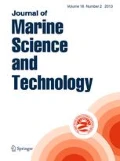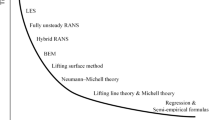Abstract
The aim of this paper is to develop a software, namely HPS-MOP, based on the multi-level and multi-point hydrodynamic optimization of hull-propeller systems during early-stage ship design. An efficient multi-objective evolutionary algorithm is used as the optimization technique to minimize the effective power and maximize the propulsive efficiency with considering some design constraints. Michell’s integral and lifting line theory are, respectively, employed for the hydrodynamic analysis of hulls and propellers in the first-level optimization. At the second level, the boundary element method is applied as a strong tool to predict the hydrodynamic performance of hulls and propellers. The ship added resistance in head waves is estimated using a fast and satisfactory semi-empirical formula. The effectiveness of the approach is illustrated by comparing the optimized results with initial ones in the optimization of series 60 hull form with DTMB P4118 single propeller and S175 hull form with KP505 twin-propeller as the original models.












Similar content being viewed by others
References
Campana EF, Peri D, Tahara Y, Stern F (2006) Shape optimization in ship hydrodynamics using computational fluid dynamics. Comput Methods Appl Mech Eng 196(1):634–651
Zakerdoost H, Ghassemi H, Ghiasi M (2013) Ship hull form optimization by evolutionary algorithm in order to diminish the drag. J Mar Sci Appl 12(2):170–179
Vernengo G, Brizzolara S, Bruzzone D (2015) Resistance and seakeeping optimization of a fast multihull passenger ferry. Int J Offshore Polar Eng 25(01):26–34
Grigoropoulos G, Campana E, Diez M, Serani A, Goren O, Sariöz K, Danişman D, Visonneau M, Queutey P, Abdel-Maksoud M, Stern F (2017) Mission-based hull-form and propeller optimization of a transom stern destroyer for best performance in the sea environment. In: Proceedings of the VII international congress on computational methods in marine engineering (MARINE'17); May 2017; Nantes, France
Yu J-W, Lee C-M, Lee I, Choi J-E (2017) Bow hull-form optimization in waves of a 66,000 DWT bulk carrier. Int J Nav Archit Ocean Eng 9(5):499–508
Diez M, Campana EF, Stern F (2018) Stochastic optimization methods for ship resistance and operational efficiency via CFD. Struct Multidiscip Optim 57(2):735–758
Kuiper G (2010) New developments and propeller design. J Hydrodyn Ser B 22(5):7–16
Xie G (2011) Optimal preliminary propeller design based on multi-objective optimization approach. Procedia Eng 16:278–283
Mirjalili S, Lewis A, Mirjalili SAM (2015) Multi-objective optimisation of marine propellers. Procedia Comput Sci 51:2247–2256
Kamarlouei M, Ghassemi H, Aslansefat K, Nematy D (2014) Multi-objective evolutionary optimization technique applied to propeller design. Acta Polytech Hung 11(9):163–182
Nelson M, Temple D, Hwang J, Young Y, Martins J, Collette M (2013) Simultaneous optimization of propeller–hull systems to minimize lifetime fuel consumption. Appl Ocean Res 43:46–52
Ghassemi H, Zakerdoost H (2017) Ship hull–propeller system optimization based on the multi-objective evolutionary algorithm. Proc Inst Mech Eng Part C J Mech Eng Sci 231(1):175–192
Kim Y, Kim K-H (2007) Numerical stability of Rankine panel method for steady ship waves. Ships Offshore Struct 2(4):299–306
Xu H-F, Zou Z-J, Wu S-W, Liu X-Y, Zou L (2017) Bank effects on ship–ship hydrodynamic interaction in shallow water based on high-order panel method. Ships Offshore Struct 12(6):843–861
Michell JH (1898) The wave resistance of a ship. Philos Mag 45:106–123
Epps BP, Kimball RW (2013) Unified rotor lifting line theory. J Ship Res 57(4):181–201
Wrench J Jr (1957) The calculation of propeller induction factors AML problem 69-54. David Taylor Model Basin, Washington DC
Ghassemi H, Ghadimi P (2008) Computational hydrodynamic analysis of the propeller–rudder and the AZIPOD systems. Ocean Eng 35(1):117–130
Ghassemi H, Kohansal A (2010) Hydrodynamic analysis of non-planing and planing hulls by BEM. Sci Iran Trans B Mech Eng 17(1):25–41
Van Manen J, Van Oossanen P (1988) Principles of naval architecture, vol 2. The Society of Naval Architects and Marine Engineers, New Jersey
Strom-Tejsen J, Hugh YHY, Moran DD (1973) Added resistance in waves. SNAME Trans 81:250–279
Liu S, Papanikolaou A (2016) Fast approach to the estimation of the added resistance of ships in head waves. Ocean Eng 112:211–225
Carlton J (2012) Marine propellers and propulsion. Butterworth-Heinemann, Oxford
Zhang Q, Li H (2007) MOEA/D: a multiobjective evolutionary algorithm based on decomposition. IEEE Trans Evol Comput 11(6):712–731
Zhang Q, Liu W, Li H (2009) The performance of a new version of MOEA/D on CEC09 unconstrained MOP test instances. Proceedings in IEEE Congress of Evolutionary Computation (CEC 2009); May 18th-21st 2009; Trondheim, Norway. IEEE
Yuen TJ, Ramli R (2010) Comparision of computational efficiency of MOEA\D and NSGA-II for passive vehicle suspension optimization. ECMS 2010:219–225
Zhang Q-B, Feng Z-W, Liu Z-M, Yang T (2009) Fuel-time multiobjective optimal control of flexible structures based on MOEA/D. J Natl Univ Def Technol 6:015
Acknowledgements
The HPS-MOP software is prepared by MATLAB language. The computational results presented in this paper have been performed on the parallel machines of the high-performance computing research center (HPCRC) of Amirkabir University of Technology (AUT). Their supports are gratefully acknowledged.
Funding
The author(s) received no financial support for the research, authorship, and/or publication of this article.
Author information
Authors and Affiliations
Corresponding author
Ethics declarations
Conflict of interest
The authors declared no potential conflicts of interest with respect to the research, authorship, and/or publication of this article.
Additional information
Publisher's Note
Springer Nature remains neutral with regard to jurisdictional claims in published maps and institutional affiliations.
About this article
Cite this article
Zakerdoost, H., Ghassemi, H. Hydrodynamic optimization of ship’s hull-propeller system under multiple operating conditions using MOEA/D. J Mar Sci Technol 26, 419–431 (2021). https://doi.org/10.1007/s00773-020-00747-0
Received:
Accepted:
Published:
Issue Date:
DOI: https://doi.org/10.1007/s00773-020-00747-0




